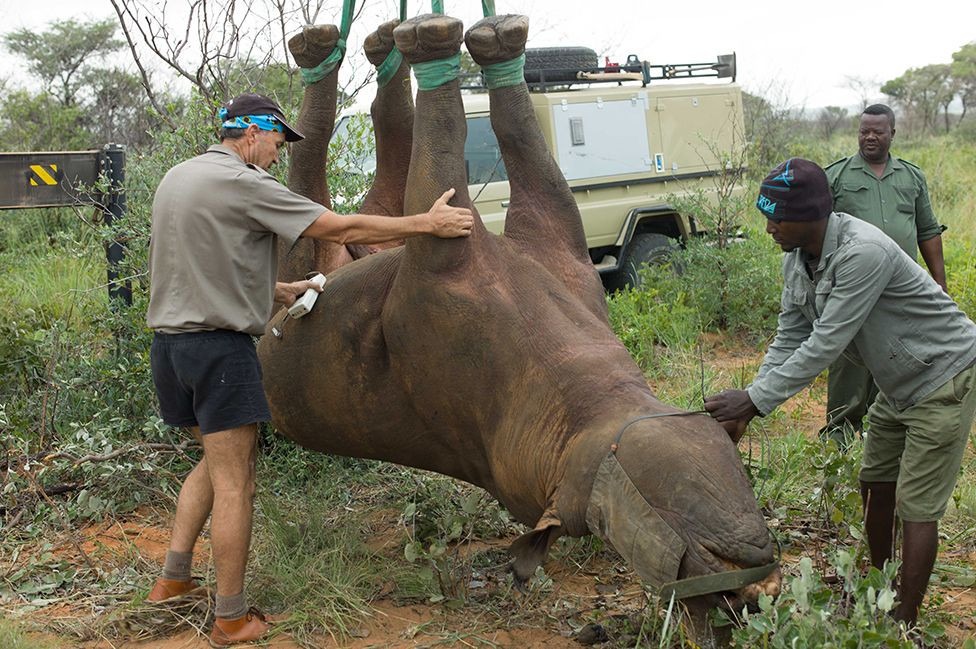
Researchers who hung 12 rhinoceros in the air upside down for 10 minutes win 2021 Ig Nobel Prize
Researchers have been awarded the 2021 Ig Nobel prize after conducting an experiment where rhinoceroses were hung upside down to see what effect it had on the animal’s health.
The Ig Nobel prizes are not as famous as the Nobel prizes but it is given to researchers who carry out researchers that first make you laugh but then make you think.
Other recipients of the 2021 prize included teams that studied the bacteria in chewing gum stuck to pavements, and how to control cockroaches on submarines.
The awards ceremony was conducted online as it couldn’t take place at the Harvard University in the US because of Covid restrictions.
The science humour magazine, Annals of Improbable Research, says the rhino study deserved this year’s honour because “what could seem more daft than hanging 12 rhinos upside down for 10 minutes?”
The research was carried out by wildlife veterinarian Robin Radcliffe, from Cornell University, and colleagues in Namibia because they wanted to know if the health of the animals might be compromised when slung by their legs beneath a helicopter or crane.
He noted that: “Namibia was not the first country to move rhinos upside down with helicopters, but they were the first to take a step back and say, ‘hey, let’s study this and figure out, you know, is this a safe thing to do for rhinos?”
And so, his team, in collaboration with the Namibian Ministry of Environment, Forestry, and Tourism, suspended 12 tranquillised black rhinoceroses by their feet from a crane, and measured their physical responses.
They found out that the animals coped very well with evidence showing the rhinos did better in this unusual position than simply lying chest down or on their side.
“I think the reason for that is, when a rhino is on its side, you have positional effects of blood flow. So in other words, the lower parts of the lung are getting lots of blood flow for gas exchange, but the upper part of the lung, just because of gravity, is not getting perfused well, so when a rhino is hanging upside down, it’s basically like it’s standing upside up; the lung is equally perfused.
“We’ve also seen that rhinos that are on their side too long, or on their sternum, especially – they get muscle damage, they get myopathy, because they’re so heavy. And there’s no pressure on their legs, other than the sense of the strap around their ankle,” Robin explained.
The prizes on the night were handed out by real Nobel laureates, including Frances Arnold (chemistry, 2018), Carl Weiman (physics, 2001), and Eric Maskin (economics, 2007).
· Below Is The Full List Of 2021 Ig Nobel AwardWinners:
Biology Prize: Susanne Schötz, for analysing variations in purring, chirping, chattering, trilling, tweedling, murmuring, meowing, moaning, squeaking, hissing, yowling, howling, growling, and other modes of cat-human communication.
Ecology Prize: Leila Satari and colleagues, for using genetic analysis to identify the different species of bacteria that reside in wads of discarded chewing gum stuck on pavements in various countries.
Chemistry Prize: Jörg Wicker and colleagues, for chemically analysing the air inside movie theatres, to test whether the odours produced by an audience reliably indicate the levels of violence, sex, antisocial behaviour, drug use, and bad language in the movie the audience is watching.
Economics Prize: Pavlo Blavatskyy, for discovering that the obesity of a country’s politicians may be a good indicator of that country’s corruption.
Medicine Prize: Olcay Cem Bulut and colleagues, for demonstrating that sexual orgasms can be as effective as decongestant medicines at improving nasal breathing.
Peace Prize: Ethan Beseris and colleagues, for testing the hypothesis that humans evolved beards to protect themselves from punches to the face.
Physics Prize: Alessandro Corbetta and colleagues, for conducting experiments to learn why pedestrians do not constantly collide with other pedestrians.
Kinetics Prize: Hisashi Murakami and colleagues, for conducting experiments to learn why pedestrians sometimes collide with other pedestrians.
Entomology Prize: John Mulrennan Jr and colleagues, for their research study “A New Method of Cockroach Control on Submarines”.
Transportation Prize: Robin Radcliffe and colleagues, for determining by experiment whether it is safer to transport an airborne rhinoceros upside down.

